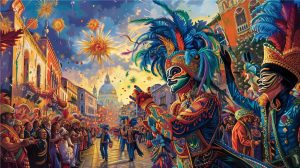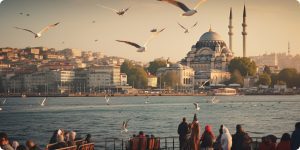Places that Tourists Shouldn’t Miss
Content
- Aveiro: The Venice of Portugal
- Évora: A Glimpse into Portugal’s Golden Age
- Ponta Delgada: The Azure Archipelago
- Coimbra: A Blend of Tradition and Hidden Wonders
- FAQ
Lesser-known places offer a deeper insight into Portugal’s rich cultural and natural heritage, as well as enriching your travelling experience with their unique stories and serene beauty. So the next time you visit Portugal, dare to venture a little off the beaten track and discover these wonderful places that await you.
Read Ready, Set, Fly: Simple Steps to Prepare for a Long Flight
Aveiro: The Venice of Portugal
Aveiro’s comparison to Venice can be attributed primarily to its scenic canals. A boat tour on a traditional moliceiro is the best way to experience these canals. Originally used for seaweed harvesting, these boats are now beautifully painted with bright colors and intricate designs, reflecting the local culture and traditions. As you glide along the calm waters, you’ll pass under historical bridges and alongside Art Nouveau buildings, gaining a waterfront perspective of the city’s architectural beauty.
Aveiro’s comparison to Venice can be attributed primarily to its scenic canals. A boat tour on a traditional moliceiro is the best way to experience these canals. Originally used for seaweed harvesting, these boats are now beautifully painted with bright colors and intricate designs, reflecting the local culture and traditions. As you glide along the calm waters, you’ll pass under historical bridges and alongside Art Nouveau buildings, gaining a waterfront perspective of the city’s architectural beauty.
Cultural Exploration at Museu de Aveiro
The Museu de Aveiro, also known as the Museum of Santa Joana, is housed in a former convent and is dedicated to Princess Saint Joana, who lived in the convent during the 15th century. The museum showcases a rich collection of religious art, including stunning paintings, sculptures, and artifacts that provide insight into Aveiro’s spiritual and cultural history. The highlight of the museum is the lavish tomb of Princess Saint Joana, an exquisite example of Renaissance art that attracts visitors from around the world.
Évora: A Glimpse into Portugal's Golden Age
Évora, a city that resonates with the echoes of the past, is encircled by ancient walls and filled with monumental landmarks. Yet, it is the hidden corners and less visible attractions that offer some of the most intriguing experiences.
Capela dos Ossos
Within the walls of the Church of St. Francis lies an extraordinary chapel known as the Capela dos Ossos. This chapel, adorned with the bones of over 5,000 monks, serves as a meditation on life’s transience. The eerie yet captivating atmosphere of the chapel invites reflection and offers a unique perspective on the historical practices of Portuguese monastic communities.
https://www.visitevora.net/capela-ossos-evora/
Ponta Delgada: The Azure Archipelago
Ponta Delgada, the capital of the Azores, serves as a gateway to the volcanic wonders of the archipelago. Many tourists call it European Hawaii.
Quinta das Raiadas
Originally established as a private estate, it has witnessed numerous transformations and played a pivotal role in the local culture. Today, Quinta das Raiadas offers a real journey back in time. Learn to knead bread and bake it in a wood-fired oven like in the old days, try ploughing the land with centuries-old crops, have fun milking the Estrellinha cow and ride horses or carts.
Seasonally, Quinta das Raiadas transforms with the landscape. In spring, the gardens are a burst of color with flowers in full bloom, making it a photographer’s paradise. Summer offers the perfect climate for enjoying the outdoor pool and nighttime stargazing events. Autumn brings the harvest, a bustling time filled with the excitement of grape picking and wine festivals.
https://quintadasraiadas.com/
Coimbra: A Blend of Tradition and Love Story
Coimbra is best known for its university, one of the oldest in Europe. The city holds corners and crevices filled with treasures that beckon the curious traveler.
Biblioteca Joanina – A Baroque Masterpiece
First on our list is the stunning Biblioteca Joanina, an 18th-century baroque library situated within the University of Coimbra. Famous for its opulent interiors and rare, ancient manuscripts, this library also has a unique feature – its colony of bats! These nocturnal creatures are natural protectors of the books, feeding on insects potentially harmful to the manuscript collections.
https://visit.uc.pt/en/space-list/joanina
Quinta das Lágrimas – A Tale of Love and Tragedy
For those captivated by tales of love and tragedy, Quinta das Lágrimas offers a poignant backdrop. This palace is famed as the setting for the tragic love story of Prince Pedro and Inês de Castro, a tale that has inspired artists and writers for centuries.
The place has now become an atmospheric hotel. Guests can explore its historical gardens, where the tears of Inês are said to have formed a small spring after her untimely death.
https://www.quintadaslagrimas.pt/
Cais da Ribeira: Porto's Historic Waterfront
The history of Cais da Ribeira is as colorful as the houses that line its waterfront. Originating in the medieval period, this area has been a bustling hub of commerce and social life for centuries. Historically, it was the site of Porto’s main market, where goods from across the globe were traded. Over the years, Ribeira has witnessed significant events, including invasions and regal ceremonies
For those looking for more active pursuits, Ribeira’s streets are filled with shops selling local crafts and souvenirs. Cultural events and street performances are common, especially during the summer months
Lello Bookshop: A Literary Jewel
Founded in 1906 by brothers José and António Lello, the bookstore quickly became a cultural landmark in Porto. Its unique architectural style blends Neo-Gothic and Art Deco elements, creating an enchanting space that has hosted decades of literary discussions and events. Lello has been a gathering place for intellectuals and artists, influencing Porto’s literary scene significantly.
https://www.instagram.com/livraria.lello/
Lello’s charm is not limited to its physical beauty; its literary connections run deep. Rumor has it that J.K. Rowling, who lived in Porto in the early 1990s, frequented Lello during her time in the city, drawing inspiration for her Harry Potter series from its magical ambiance.
The Douro Valley is a testament to the transformative power of human endeavor. Here, the Douro River meanders through deep valleys, framed by hillsides meticulously terraced with vineyards that date back centuries. These terraces not only cultivate world-class grapes but also create a patchwork of incredible beauty that changes hues with the seasons—from the lush green of spring to the fiery reds and oranges of autumn. Each vista in the Douro promises postcard-worthy scenes, particularly at sunrise or sunset when the light casts golden tones over the river.
https://www.instagram.com/douro.valley/
River cruises provide a leisurely way to view the valley’s stunning contours, while tailored tours can include anything from helicopter rides for aerial views to personalized wine tours guided by local experts.
Madeira: Magical Islands
Madeira’s striking natural beauty is characterized by its dramatic, rugged cliffs that descend into the clear blue waters of the Atlantic. The island’s heart is dominated by the Laurisilva forest, a dense and ancient laurel forest that covers about 20% of the island’s area. Designated a UNESCO World Heritage site, this forest is one of the most significant remnants of a type that once covered much of Southern Europe.
https://www.instagram.com/visitmadeira/
Adventure seekers will find Madeira a thrilling playground. The island’s unique system of levadas (irrigation channels) offers over 2,000 kilometers of accessible hiking trails that provide immersive experiences in the island’s natural beauty. For those looking for a rush, paragliding off the cliffs of Arco da Calheta offers unparalleled views of the island, while the clear waters surrounding Madeira are perfect for scuba diving, revealing a rich marine biodiversity.
Monte Palace Tropical Garden
Monte Palace Tropical Garden is one of Madeira’s most exquisite treasures. The history of Monte Gardens is as rich as the flora it houses. Originally the site of an 18th-century estate, the property was transformed into a hotel in the late 19th century, known then as the Monte Palace Hotel. After falling into disrepair, the garden was revitalized in the 1980s by José Berardo, who envisioned a space that combined natural beauty with cultural heritage. Today, the garden extends over 70,000 square meters.
https://www.instagram.com/montepalacemadeira/
Pena Palace in Sintra
Pena Palace is an architectural marvel that showcases a vivid mix of Gothic, Renaissance, Moorish, and Manueline styles. Its exterior is characterized by terracotta tiles, mythological statues, and ornate window frames, painted in an array of colors that accentuate its fairy-tale appearance.
The palace’s famous clock tower, visible from many points in Sintra, is topped with a conical spire that seems to touch the sky. Inside, each room is a world unto itself, decorated with exquisite furnishings and ornamental carvings that reflect the eclectic tastes of King Ferdinand II, who commissioned the palace as a summer residence.
Cristo Rei: Lisbon’s Watcher
Inspired by Rio de Janeiro’s Christ the Redeemer, this iconic monument is not only a symbol of faith but also offers one of the best panoramic views of the Portuguese capital.
Reaching Cristo Rei involves a short ferry ride from Lisbon to Almada followed by a bus ride to the monument, allowing visitors to enjoy the Lisbon skyline. The best times to visit are early morning or late afternoon when the light beautifully accentuates the statue and the city beyond. At the base, the viewing platform offers a breathtaking 360-degree view of the surrounding landscape, including the 25 de Abril Bridge and the distant Serra da Arrábida.
FAQ
What is the best time of year to visit Portugal?
The best time to visit Portugal for favorable weather and fewer crowds is during the spring (March to May) or early fall (September to October). These seasons offer mild temperatures and less rainfall.
Do I need a car to visit these locations?
While public transport in Portugal can take you to most major cities, having a car provides greater flexibility. If you don’t drive, book a private ride through GetTransfer.com
From Porto to Aveiro (~87 km) – economy $67, comfort $75, minivan $103, minibus $228
From Lisbon to Évora (~131 km) – economy $76, comfort $93, minivan $128, minibus $249
From Porto to Coimbra (~136 km) – economy $108, comfort $116, minivan $147, minibus $332
Are there any entry fees for these attractions?
Some locations, especially those within historical or preservation sites, may charge a small entry fee. It’s best to check the official websites or contact the sites directly for the most accurate information on opening hours and entrance fees.













